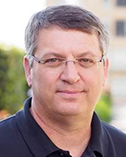
David G. Drubin
University of California, Berkeley
|
Primary Section: 22, Cellular and Developmental Biology Secondary Section: 29, Biophysics and Computational Biology Membership Type:
Member
(elected 2022)
|
Biosketch
David Drubin is a cell biologist and biochemist who studies membrane trafficking and the cytoskeleton. His work has uncovered fundamental mechanisms of actin cytoskeleton assembly regulation and endocytic internalization of cargo molecules into yeast and human stem cells. Drubin was born in Tarrytown, New York and mostly grew up in California with brief periods in Michigan and Massachusetts. He graduated from the University of California, Berkeley in 1980 with a bachelor's degree in biochemistry and from the University of California, San Francisco in 1985 with a Ph.D. in Biochemistry. After completing his postdoctoral studies at the Massachusetts Institute of Technology, he joined the faculty at the University of California, Berkeley in 1988. At Berkeley he has served as Head of the Molecular and Cell Biology graduate program, Head of the Division of Cell and Developmental Biology, and as Department co-Chair. For 10 years he served as Editor-In-Chief of Molecular Biology of the Cell, the research journal of the American Society for Cell Biology. Drubin has been elected to the American Academy of Arts and Sciences and the National Academy of Sciences.
Research Interests
The Drubin laboratory studies of the actin cytoskeleton and membrane trafficking in budding yeast and human stem cells. By combining biochemical and cell-based assays, mechanisms that regulate actin filament nucleation, assembly, stability and disassembly have been elucidated. Cofilin was shown to be crucial for actin filament turnover in vivo using genetics and cell biology. A yeast extract system that supports actin assembly on beads coated with specific yeast proteins was used in this system to discover novel filament capping activities and cell cycle regulation of actin cable assembly. Two-color, live-cell imaging elucidated a complex pathway in which endocytic proteins are recruited in a predictable order and actin assembly drives the final steps of vesicle formation. A theory collaboration developed new concepts, notably that scission can be driven by an evolving line tension and that membrane mechanics and biochemical reactions can feed back on each other. The Drubin lab pioneered genome-editing to make in-frame fusions of proteins of interest to fluorescent proteins in human cells to study protein dynamics and levels in living cells while maintaining physiological protein stoichiometry. By differentiating genome-engineered stem cells to various other cell types, how endocytosis is modified in neurons, epithelial cells and cardiomyocytes was revealed.

